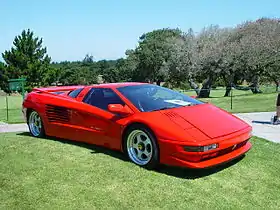Cizeta-Moroder V16T
The Cizeta-Moroder V16T, now known as just the Cizeta V16T, is an Italian sports car (built from 1991 to 1995) created by automotive engineer Claudio Zampolli in a joint venture with music composer Giorgio Moroder and designed by the famed Marcello Gandini. It was the only product of the Cizeta company. It was developed by a group of ex-Lamborghini employees and initially introduced in 1988.
| Cizeta-Moroder V16T | |
|---|---|
 | |
| Overview | |
| Manufacturer | Cizeta Automobili |
| Production |
|
| Designer | Marcello Gandini[2] |
| Body and chassis | |
| Class | Sports car |
| Body style | |
| Layout | RMR layout |
| Related | Lamborghini Diablo |
| Powertrain | |
| Engine | 6.0 L V16 (two Lamborghini Urraco 90° DOHC flat-plane V8s in a single block) |
| Transmission | 5-speed manual[3] |
| Dimensions | |
| Wheelbase | 2,694 mm (106.1 in)[3] |
| Length | 4,445 mm (175.0 in)[3] |
| Width | 2,057 mm (81.0 in)[3] |
| Height | 1,115 mm (43.9 in)[3] |
| Curb weight | 1,700 kg (3,700 lb)[3] |
History
The Cizeta-Moroder name comes from the Italian pronunciation of designer Claudio Zampolli's initials (CZ) (Ci-Zeta). The V16T signifies that its engine is a V16 mounted transversely in the central rear position, just forward of the rear axle and behind the passenger seats. The engine is indeed a true V16. Sharing a single cylinder block, and four-cylinder heads with gearing between the heads, providing a single output from the center of the engine assembly to the five-speed transaxle.
Design
.jpg.webp)
The chassis was formed of chrome-moly elliptical steel tubing, wrapped in a sleek body designed by Marcello Gandini, and Claudio Zampolli, who had previously designed the Lamborghini Countach and some aerodynamic Maseratis. The front nose shape of the V16T is from an original design for the Lamborghini Diablo by Marcello Gandini. However, in 1987 when Chrysler obtained controlling interest in Lamborghini, their design team "softened" the edges and generally modified Gandini's original design, leaving Gandini famously unimpressed. Gandini then joined forces with Claudio Zampolli and they conceived the Cizeta.
Production
The car was viewed from the beginning as an exclusive sports car, easily capable of achieving a top speed of 328 km/h (204 mph) and required just 4 seconds to accelerate from 0 to 100 km/h (62 mph), while at the same time equipped with many luxury features.
In 1991, the list price for a Cizeta was an estimated (US dollars) $650,000. Although predictions for production foresaw one car per month, only 12 examples (including 1 prototype) were actually built from 1991 until the company moved its operation to Los Angeles, California in 1995. Subsequently, 2 more cars were completed (one coupe and one spyder) in 1999 and 2003.
As of May 1, 2006, the car was still in production on a made-to-order basis, although now priced at $650,000, or $850,000 for the Spyder TTJ, exclusive of shipping, taxes, and extras. According to a 2018 interview, Zampolli considered the car still theoretically in production and available to purchase as late as 2018, although none had been built since the 2003 spyder. [4]
Controversy
Moroder's involvement
At some point after the car's debut, Giorgio Moroder and Claudio Zampolli parted ways. It is known that Claudio Zampolli designed the logo for the car, and Giorgio Moroder paid for the art development. The Cizeta, from 1990 to date, is no longer associated with Moroder; its name remains symbolic of Moroder's hi-tech music and glamorous lifestyle. In addition, while the car debuted (temporarily) as the Cizeta-Moroder, all delivered cars were badged simply as Cizeta V16T.
References
- "About". www.cizetav16t.com. Archived from the original on 2007-05-17. Retrieved 2009-10-19.
- "1995 Cizeta-Moroder V16T". www.supercars.net. Archived from the original on 2013-01-12. Retrieved 2008-03-31.
- "1988 Cizeta-Moroder V16T". www.carfolio.com. Retrieved 2008-03-31.
- https://www.hagerty.com/media/car-profiles/16-cylinder-italian-exotic-cizeta-moroder-v16t/%7Caccess-date=2020-07-06
External links
| Wikimedia Commons has media related to Cizeta-Moroder V16T. |